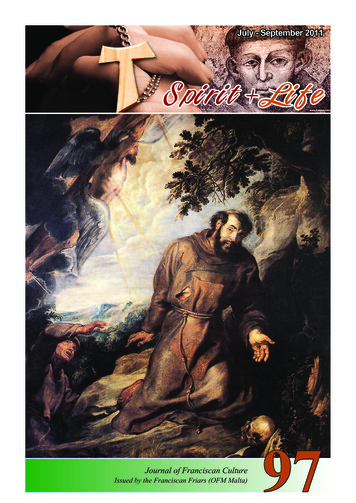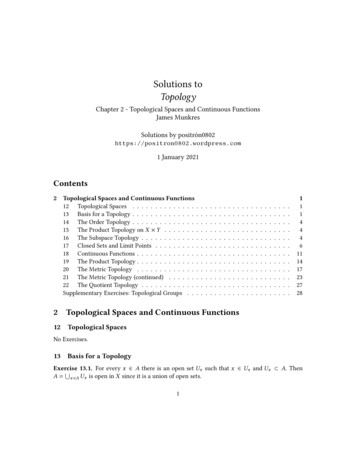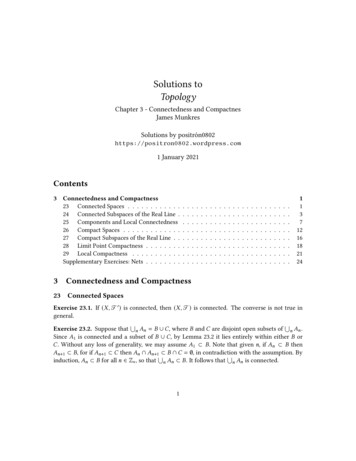
Transcription
Journal of Franciscan CultureIssued by the Franciscan Friars (OFM Malta)97
EditorialEDITORIALTHE TRUE NATUREOF ONGOINGFORMATIONQuarterly journal ofFranciscan culture publishedsince April 1986.Layout:John Abela ofmComputer Setting:Raymond Camilleri ofmAvailable at:http://www.i-tau.comAll original material isCopyright TAU FranciscanCommunications 2011Contents Editorial. 2 Brother Leo of Assisi,Companion of St. Francis. 3 The Last Supper of St. Francis and the image of the NewAdam (1). 10 Life of St. Francisof Assisi. 17 Quote. 23972There is no denying that consecrated religious life in the Churchis at a crossroad. Many have blamed the shortage of vocationsas the real reason for this crisis, but the true picture is very different. It is easy to blame external factors such as shortage ofvocations in order to hide one’s head in the sand and not facethe true reasons for the crisis in religious life. The Order of Friars Minor is one of the largest religious families in the Church.Yet it has suffered from an acute decrease in numbers in theselast decades. Indeed, since 1975 the Franciscan Order has decreased to nearly half of what it was then. True, religious Ordersare all suffering from decreasing numbers, but the percentageof friars abandoning the Franciscan Order has been greater. Sowhere is the problem? Maybe the real problem has to do withformation in the Order. Because of its true democratic characterwhich is the pride of us Franciscans, the Order also faces thechallenge of the danger of being fractured. It has been so for allits long life. I insist, interior freedom is the characteristic markof the Franciscan and nobody will dare change this. But freedomdoes not mean disagreement over the fundamental values whichmake up Franciscan life. Unfortunately in some sections of theOrder this is exactly what is happening. We are discussing whatthe identity of the Franciscan friar is, whether we should be aclerical or lay Order, whether we should continue praying in aconventual and monastic way or choose new forms of prayer,what does our poverty imply in practice. The end result is that wehave been experimenting over and over again, and are arrivingnowhere. Maybe we were better off when things were clear-cutin our legislation. Maybe it is high time we return to become acounter-current family, just as we were born in the radical choiceof Francis of Assisi. To be fraternal does not mean to welcomeeverybody and everything without a criterion of healthy discernment. It means that our ongoing formation is fundamental,but that it cannot just be an aesthetic polishing of structures buthas to go deep into the heart of our existence. It means knowing our tradition, loving our saints and teachers, loving our rootsand never yielding to half-measures. It also means being proudof who we are without being haughty, but also clear in the factthat there is no such thing as vague expressions like “we are allthe same”. If we are religious Franciscans, we are not the sameas others. We are different. We have to look different. We haveto believe that our Franciscan habit is not an ancient mediaevaldress which is now out of fashion, that our liturgical prayer isnot a practice adapted for monks but not for us, that our povertyis not just a slogan to be defenders of the poor without sharing their lot. Otherwise we will be lost in a new age of globalisation in which the logic of the cross is falling into oblivion.Noel Muscat ofmSPIRIT LIFE - July - September 2011
I Franciscan OrderBROTHER LEO OF ASSISI,COMPANION OFSAINT FRANCIS (1)Wieslaw BlockEnglish translation and adaptation of a paper by Wieslaw Block, published in «Frate Francesco» 77/1 (2011) 7-32.Brother Leo is a very important personageamong the group of the first brothers of Francis of Assisi.His entire life was characterised by a special friendshipwith the Saint and by a profound life of prayer. Thispaper is based upon the affirmations of the FranciscanSources and other texts of the period, and has the aimof describing the development of his spirituality, firstduring the period of his intimate closeness to Francis,and later, after the death of the Saint, as a living witnessof the primitive period of the Franciscan spring.1. The Life of Brother LeoLeo was born at the end of the 12th centuryprobably in Assisi. 1 Even though many sources narrateepisodes from the life of brother Leo, it still remainsdifficult for us to describe it, since the majority of thewitnesses present the same episodes and in the entirehagiographical work of Celano and Bonaventure he isnever mentioned by name.2 Maybe it was Leo himselfwho requested the biographers to omit his name in thebiographical sources. A clue regarding this petitionof Leo can be found in the episode in which Thomasof Celano hints at the presence of four Francis whoministered to the sick Francis. Celano does not indicatetheir names, “out of regard for modesty”:“These brothers were men of virtue, devoted toGod, pleasing to the saints, and well-liked by people.The blessed Father Francis rested upon them as a houseupon four pillars. I omit their names for the present,out of regard for modesty, which is a close friend ofthese spiritual men [ ] This virtue graced those menand made them loveable and kind to people. This gracethey all held in common, but a particular virtue alsoadorned each one. One had outstanding discernment[Angelo Tancredi?], another had extraordinary2011 July - September - SPIRIT LIFEpatience [Bernardo or Rufino?], one was famous forhis simplicity [Leo?], and the last had great physicalstrength along with gentleness of spirit [Rufino or Johnde Laudibus?].”3We know absolutely nothing regarding the lifeof Leo before his encounter with Francis. Maybe thetwo knew one another before the Saint’s conversion, aswe can deduce from these words of Thomas of Celano:“Now there was in the city of Assisi a man heloved more than all the rest. They were of the same ageand the constant intimacy of their mutual love madehim bold to share his secrets with him. He often broughthim to remote places suitable for talking, asserting thathe had found a great and valuable treasure. The manwas overjoyed, and since he was so excited about whathe heard, he gladly went with him whenever he wassummoned.”4According to Paul Sabatier, this anonymousyoung man was Leo.5 It is very probable that Leo joinedFrancis after the approval of the primitive form of life.Leo was already a priest by then, and he became theconfessor of Francis and his inseparable “secretarius– as Attilio Bartoli Langeli explains – in the originalmeaning of one of is custodian of secrets; not in themodern sense of ‘secretary’ which is misleading.”6 It is,however, also true that Leo, having a good knowledgeof Latin, could help Francis to write down his intuitions.Leo must have possessed a rather tormentedand restless spirit, but at the same time he waspreoccupied to serve the Lord in the best way and ina more perfect manner. A witness to this is the letterof Francis to Leo: “In whatever way it seems better toyou to please the Lord God and to follow His footprintsand poverty.”7 Leo often journeyed close to his friend;the presence of Francis, his words and his way of lifewere for him a constant model of evangelical life. Leo,“little lamb of God”,8 as Francis would call him, grew3
I Franciscan OrderFrancis’ Letter to Leospiritually in every moment in the school of the Gospel,following the footsteps of the Saint of Assisi.The Sources do not permit us to reconstruct thedetails of Leo’s journeys. Probably Leo lived for longperiods of time at the Portiuncula, in the period in whichPeter Cattanio was vicar general (1220-1221). Fromthe spring of 1223 Leo remained constantly by Francis,during the moment in which the Saint composed theLater Rule, as well as in 1224, when the Saint receivedthe stigmata on La Verna. It was in this place thatFrancis gave Leo another writing, the Chartula orParchment, containing the Blessing and the Praises ofthe Most High. This was a moment of pain for bothFrancis and Leo. Francis was seeing that his plan tolive the Gospel had not been completely accepted. Hewas going through an interior drama which led him tosearch for solitude and isolation. In this choice he was4faithfully followed by his companion Leo. During thefirst months of 1225 “brother little lamb” accompaniedFrancis in his preaching tour of Umbria and Marche.Then he remained close to him during his stay in Rietiand Fonte Colombo for the treatment of his eyes, aswell as during Francis’ last journey in Siena, Cortonaand Assisi in 1226, and finally during the moment ofthe Saint’s death on 3rd October 1226.We can only imagine the state of Leo after thedeath of Francis. Without his companion and friend,Leo just collapsed. His sad and afflicted spirit –according to Attilio Bartoli Langeli – found a sure pointof reference and help in Clare, who offered a completeharmony “in the faithfulness to the memory and willof Francis and, furthermore, a kind of institutionalattachment, which was helpful to a brother who wasby now willingly living a solitary life.”9 It thereforeseems plausible that Leo had helped Clare to write theLetters to Agnes of Prague.10 It is not, however, evidentthat, before the death of Clare, Leo was chaplain of thecommunity of San Damiano, since the only chaplainwe know of during that period was brother Marco.Brother Leo remained close to Clare until the day ofhis death. The Legend of Saint Clare dedicates the lastchapter of the first book to the episode of the death ofClare, who was surrounded by her sisters and by thefirst companions of Francis, Angelo and Leo:“Those two blessed companions of the blessedFrancis were standing there: Angelo was one of themwho, while mourning himself, consoled those whowere mourning; the other was Leo who kissed the bedof the dying woman.”11This witness of the Legenda helps us tounderstand the profound and intimate relationship thatunited Leo and Angelo, as well as other brothers,12to Clare, who with courage and resourcefulnesssucceeded in defending the memory and the Christianproposal which Francis had indicated to her.13 In Assisi,on the day of the death and funeral of Clare, the Popewas present with his household. Leo, together withthe other friars, certainly participated to the last ritescelebrated at San Damiano, and then he took part inthe solemn funeral in which it seems that Clare wouldhave been proclaimed a saint without a regular processof canonisation:“Like an unexpected piece of news, the wordof the untimely passing of the virgin struck the entirepopulation of the city. Men and women ran to theplace; people flooded the place in such great numberthat the city seemed deserted. Everyone proclaimed hera saint; everyone proclaimed her dear to God. Amongthe words of praise not a few flowed with tears.The Podestà with a squadron of soldiers and acrowd of armed men kept careful guard that night andday so that the loss of the precious treasure that laywithin might be prevented [ ]The next day the entire Curia came. The VicarSPIRIT LIFE - July - September 2011
I Franciscan Orderof Christ with the cardinals arrived at the place and theentire city directed its steps to San Damiano. It cametime to celebrate the divine praises when, after thebrothers had begun the Office of the Dead, the LordPope suddenly declared that the Office of the Virginsshould be celebrated, not that of the Dead. It seemed asthough he would canonize her before placing her bodyin the tomb.”14The strong link between Leo and Clare is alsoshown in the fact that, after the death of the Saint, Leowas convoked by bishop Bartolomeo Accoramboniof Spoleto,15 together with brother Angelo, Leonardarchdeacon of Spoleto, Giacomo archpriest of Treviand brother Marco, chaplain of the monastery of SanDamiano, to be part of the tribunal instituted by thesame Bartolomeo for the process of canonization ofClare, ordered by Innocent IV with the apostolic letterdated 18th October 1253. The process took place inAssisi at the end of November of the same year.After the death and canonization of Clare,Leo together with a group of brothers, continued tolive along the footsteps of Saint Francis in his searchfor solitude. In fact, he retired to small friaries andhermitages, where he had lived before with Francis.There are references to his presence in Greccio in 1246,at La Verna in 1259, at Monteripido near Perugia,probably after the death of brother Giles, that is in1262, and at the Portiuncula around 1268.16It was probably in 1263, on the occasion ofthe transfer of the Clares from San Damiano to thenew basilica where Clare was buried, that Leo andAngelo donated to sister Benedetta, the first abbess ofthe monastery after the death of Clare, the Breviary ofSaint Francis, so that she would conserve it always “inmemory and devotion of the holy father, who wouldoften read it.” This breviary has a great importance,also because Leo wrote in it some notes which reflecthis spirit.On the life of brother Leo we have scantinformation – as Enrico Menestò states – and most arenot one hundred per cent sure. We remember only theone found in the letter that Bonaventure sent from LaVerna in October 1259 to the monastery of the Claresin Assisi, in which we can deduce that Leo was thechaplain of the nuns during that particular moment.17Six years had passed from the death of Clare, andBonaventure who had been master of theology inParis, in 1257 had also become minister general. In thisnew commitment he also had to occupy himself withthe disciples of Clare and it is for this reason that hewrote the letter. Bonaventure does not hide his scarceknowledge of Clare and her sorores, but says openlythat, in order to have information, he had made recourseto brother Leo:“To the beloved daughters in Christ Jesus, theAbbess of the Poor Ladies of Assisi of the Monasteryof Saint Clare and all her sisters, brother Bonaventure,2011 July - September - SPIRIT LIFEminister general and servant of the Order of FriarsMinor, sends his greetings of health with the desire tofollow the Lamb wherever he goes, together with themost blessed virgins who are always ready to await himwhen he comes.My dear daughters in the Lord, I have shortlyknown, through our most dear brother Leo, who wascompanion of the holy Father, that you try hard toserve Christ poor and crucified in all purity as bridesof the eternal King, and for this I feel overjoyed in theLord.”18Clare, therefore, and her sisters who came afterher, remained loyal and close to brother Leo, and healso established with them a spiritual relationship inorder to serve together Jesus Christ, poor and crucified,as Bonaventure underlines in his letter.Brother Leo died on 13th November 1271 afterthe death of the other companions of Francis, Rufino(†1249) and Angelo (†1257).2. The spirituality of Brother LeoWe are not going to touch at this pointthe writings of brother Leo, which touch upon theFranciscan Question, which regards the manuscripttradition of Leo and of his companions. We shall insteadpass immediately to the description of his spirituality,presented in the light of the works that were definitelyproduced by him. On the other hand, this task remainsarduous since we do not possess texts with a uniquelyspiritual style, and with all probability, these do noteven exist. The spirituality of Leo has therefore to begleaned from his writings, which were composed with aunique aim: to keep alive the memory of his holy fatherFrancis. In the description of the spirituality of Leo,I think that we can distinguish two principal periods:the first one refers to the years lived with Francis andhis first companions, the second to the long periodfollowing the death of the founder.2.1. Leo as disciple of FrancisLeo initiated and matured his spiritualityduring the years spent close to Francis, when he didnot only walk side by side with the founder, but aboveall could listen to the secret thoughts of his heart, andmaybe sometimes – as a priest and confessor – offerhis suggestions or comment for him some Biblical text.At the same time, it was certainly Leo to be guided byFrancis, and we do possess some elements regardingthis. One is found in the so-called Liber exemplorum19that presents the memories of brother Leo handed downto us, this time, by a certain brother Pietro:“Brother Pietro narrated this fact that brotherLeo, companion of Saint Francis, confided withhim: ‘When I was still a newly-ordained priest I was5
I Franciscan Orderaccustomed to prolong the rite of the Mass. In fact Iexperienced divine consolations and therefore it wassweet for me to prolong the celebration. One dayblessed Francis called me, and speaking to me withfamiliarity, told me: My son, brother Leo, do as I tellyou: celebrate the Mass with all dignity, but do not stoptoo much during the celebrations, and conform yourselfto the usage of the other priests. If the Lord gives yousome special grace, when you finish the Mass, retireto your cell and there meditate and enjoy the divineconsolations, if heaven will concede this to you. I thinkthat this behaviour is better and more secure. In fact,because of the bystanders, it would easily be for you anoccasion of self-glory or another inordinate sentiment,and the devil would immediately steal from you themerits of this special devotion. But in your cell nobodywill see you, and you can abandon yourself withconfidence to your devotion, and there the devil will bein difficulty to find the occasion to tempt you.’”The memory of Leo went back in time, to thoseunforgettable moments in which he celebrated theEucharist for the first time. The celebration was for hima moment of grace and of profound prayer, and sincehe did not have experience, Leo prolonged it and forgotthat there were other persons around him. Francisbecame aware of this danger and counselled Leo toconform himself to the other priests in the celebrationof Mass. The memory of Leo helps us to enter intohis soul and into the spirit which guided him duringhis youthful years. He was a priest full of ideals, hisheart burned when he celebrated Mass. He experienceddivine consolations and he was not aware that othersdid not experience the same sweetness in their hearts.Francis therefore teaches Leo the way to interiority,asking him to hide the graces he received and notsuccumb to the danger of self-glory. The teaching ofFrancis was very similar to that of Jesus, who in Mt6:6 invites his disciples to pray behind closed doors totheir heavenly Father who sees in secret. We marvel atthe maturity shown by Francis, since he also was stilla young man at the time and was also at the beginningof his spiritual journey. In spite of this he takes note ofthe danger that his brother was facing, and helps himwith the words of Jesus to hide an exaggerated sense ofpiety, and without offending him, indicates to him trueevangelical piety.Another point of reference that permits us tomake further progress in rediscovering the spirit of Leois the autograph that Francis left his companion after aconversation he had with him while they were walkingtogether.20 It is difficult, indeed nearly impossible forus to date the letter. The majority of scholars thinkthat it was written during the final years of the life ofSaint Francis, maybe some time before he receivedthe stigmata and certainly not after 1224, since duringthe last two years of Francis’ life Leo was alwaysclose to him, and the two would not have needed to6communicate through letters.21 These are the words ofthe Letter:“Brother Leo, health and peace from BrotherFrancis! I am speaking, my son, in this way – as amother would – because I am putting everything wesaid on the road in this brief message and advice. If,afterwards, you need to come to me for counsel, Iadvise you thus: In whatever way it seems better to youto please the Lord God and to follow His footprint andpoverty, do it with the blessing of the Lord God and myobedience. And if you need and want to come to mefor the sake of your soul or for some consolation, Leo,come.”22Brother Leo was undoubtedly going through acrisis, since he felt that he desired to serve the Lord in abetter way, even in a perfect way. It seems typical of hisyouthful spirit to feel such a crisis. Leo was becomingaware that with the passage of years, according to hisway of seeing things, he should have served the Lordbetter. In spite of the conversation he had had beforewith Francis, the Saint decided to write a letter to him.Maybe Leo was asking his master to repeat what he hadtold him some time before, when they were walkingtogether and he requested his personal counsel andconsolation. Francis’ answer was full of motherlyaffection. In this answer we find the echo of what theLater Rule states: “Wherever the brothers may be andmeet one another let them show that they are membersof the same family. Let each one confidently makeknown his need to the other, for if a mother loves andcares for her son according to the flesh, how much morediligently must someone love and care for his brotheraccording to the Spirit?”23 The Poverello addresses Leowith the same spirit and speaks to him like a mother(sicut mater) to her son, giving him clear indicationsabout how he should proceed, and at the end of theletter, inviting him to come to meet him.J. Dalarun, speaking about the relationshipmother-son, says: “The mother stands for the ministerjust as the father for the abbot. Maternity is the figureof a government of service.”24Certainly Francis and Leo did meet andconversed together, but we do not possess any clueas to the content of their conversation. The text ofthe Letter indicates in what direction Francis’ counselmight have gone, since he writes: “In whatever wayit seems better to you to please the Lord God and tofollow His footprint and poverty, do it with the blessingof the Lord God and my obedience.” This counseluncovers the kind of formation that Francis transmittedto his brothers. To follow the footsteps and povertyof Jesus Christ is a dominant indicative, an excellentprecept. The Friars Minor should live according tothis proposal; it was the forma vitae of their newbornspirituality. This counsel of Francis has to be seen withinthe framework of the new way of life and practice ofthe evangelical “hierarchy”, described in the doubleSPIRIT LIFE - July - September 2011
I Franciscan OrderFrancis’ blessing to Leoexpression mother-minister. Whereas to the motherminister of the Franciscan fraternity one applies thenotion of consilium, to the relationship father-abbot ofthe monastic community, one has to apply the notion ofmandatum. At the same time, Francis uses another verbin the expression, namely disponere. Francis writes toLeo: dispono et consilio. Disponere means first of allto organize, or to institute, to prescribe, to ordain. Leocomes to know that his mother-friend wanted to gatherall the words that he had told him along the way (omniaverba) in one single word (oc verbo) – the word of hisconsilium, which becomes a decree and an order.Concluding the first part of the letter we seehow Leo and Francis had spoken along the way, andthat this conversation was newly recorded by Leo inthe request for the letter. Francis transformed all thisin his letter of answer in a few words, or better still ina word of counsel-order, indicating to his friend thatwhich was truly important, namely to live simply theprecept of the Gospel by following the footprints andthe poverty of Jesus Christ. This precept is none otherthan the heart of the evangelical vocation of the Saint2011 July - September - SPIRIT LIFEand his brothers.The lesson does not end here. Afterhaving given him this fundamentalindication, Francis leaves to his companiontotal freedom to live it out in his daily life,in whatever way it seemed better for him,according to true obedience. In fact, theThird Admonition reminds us: “Whateverhe does and says which he knows is notcontrary to his (the superior’s) will is trueobedience, provided that what he does isgood.”25 The spirit of Leo and of the otherbrothers grew in this double climate oftrust: trust towards the Lord, who is ingrade of guiding those who, through divineinspiration, have began to live this life,and also trust towards one’s own brothers,who are also responsible for one’s ownvocation.After having answered to the requestof his friend, the Saint concludes histhoughts indicating to Leo not to comeback to him: “if you need and want tocome to me for the sake of your soul or forsome consolation, Leo, come.” The sense,however, should be: “you do not need tocome to me for the sake of your soul orfor some consolation.” This prohibition,written by Francis himself, remainsdifficult to understand, but maybe it is notan expression of hard-heartedness,26 butsimply expresses a real difficulty: we arefar away from one another – says Francis– and therefore I am sending you this letterto contact you; I do not need to continue to talk to you,since by now I have already given you my advice. Butimmediately afterwards Francis seems to feel sorry forhaving said so, and adds the second part permitting Leoto return to him for the sake of the good of his soul.27The first part of the letter is essentially juridical, then inthe later addition Francis’ style becomes more spiritual.Leo learns from the words written directly by the Saintthat his mother-friend will always remain his spiritualfather, his faithful and trustworthy brother, his point ofreference and his spiritual councillor and help, who isalways ready to see him every time Leo feels that heneeds to return to him.There is another Source where we find theelements that describe the spirit of brother Leo. Thistime the companion of Francis is presented in thestate of anguish and of a spiritual crisis, which hadbeen tormenting him for a long time. We are duringthe unforgettable Lent that Francis spent between 15thAugust and 29th September on Mount La Verna. TheMemoriale gives us an account of what happened. Thedescription is also taken up with small variations by theLegenda Maior XI,9 and the Legenda minor IV,628:7
I Franciscan Order“While the saint was secluded in a cell onMount La Verna, one of his companions was yearningwith great desire to have something encouraging fromthe words of our Lord, commented on briefly by SaintFrancis and written with his own hand. He believedthat by this means he would be set free from, or at leastcould bear more easily, a serious temptation whichoppressed him, not in the flesh but in the spirit. Thoughgrowing weary with this desire, he feared to expressit to the most holy father. But what man did not tellhim, the Spirit revealed. One day Saint Francis calledthis brother and said: ‘Bring me paper and ink, becauseI want to write down the words of the Lord and hispraises upon which I have meditated in my heart.’ Whathe had asked for was quickly brought to him. He thenwrote down with his own hand the Praises of God andthe words he wanted and, at the end, a blessing for thatbrother, saying: ‘Take this paper for yourself and keepit carefully to your dying day.’ The whole temptationdisappeared immediately. The letter was preserved;and later it worked wonders.”29Francis first wrote the Praises, using oneside of the parchment; then in a second moment, hemade use of the backside of the same parchment inorder to write the Blessing to brother Leo, asking theLord to bless him. In fact, more than a simple text,that parchment was intended – by the hagiographersThomas of Celano and Bonaventure – as a powerfulrelic, written by Francis at the moment of the stigmata.In the texts of Celano and Bonaventure we findthe mention of a “serious temptation, not of the fleshbut of the spirit,” which disturbed the heart of Leo.What kind of temptation was Francis’ friend sufferingfrom? Neither Celano nor Bonaventure provide theanswer. In their redaction of the facts Francis, afterhaving written the Praises and the Blessing, returnsto Leo saying: “Take this paper for yourself and keepit carefully to your dying day.”30 Instead, in the Littlemanuscript31 we find another detail, which is veryinteresting, since it affirms that the serious temptationregarded the observance of the Rule: «Accipe hancchartam, et custodias regulam diligenter usque addiem mortis tue.» The omission of regulam in Celanoand Bonaventure makes us think that the object ofLeo’s cherishing the parchment was its value as a relic,whereas the proposal of ms. Little recalls in some wayhis faithfulness to the Rule.The idea that brother Leo was being disturbedbecause of the failings of the Rule remain, therefore,only a hypothesis, according to which we canunderstand why he made recourse to Francis to haveconsolation and comfort and – maybe – also a counselon how to follow in a better way the footsteps of theLord.32To be continued 8NOTES123456789101112131415A different tradition states that Leo was born in Viterbo, cfr.E. Menestò, Leone e i compagni di Assisi, in I compagni diFrancesco e la prima generazione minoritica. Atti del XIXConvegno internazionale (Assisi, 17-19 ottobre 1991), Societàinternazionale di Studi Francescani, Spoleto 1992, 41.The first modern author who presented a life of brother Leo wasPaul Sabatier, in the occasion of the edition of the Speculumperfectionis. According to Sabatier Leo was author of the Speculum. Cfr. P. Sabatier, Speculum Perfectionis, seu S. FrancisciAssisiensis Legenda antiquissima, auctore fratre Leone, Paris1898.1C 102 (FAED I, 272).1C 6 (FAED I, 187).Cfr. P. Sabatier, Études inédites sur saint François d’Assise,Paris 1932, 163. Other scholars indicate brother Elias, who isnot mentioned among the first companions.A. Bartoli Langeli, Gli autografi di frate Francesco e di frateLeone (Corpus Christiano
never mentioned by name.2 Maybe it was Leo himself who requested the biographers to omit his name in the biographical sources. A clue regarding this petition of Leo can be found in the episode in which Thomas of Celano hints at the presence of four Francis who ministered to th











